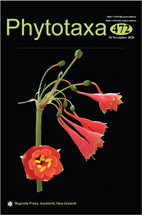Abstract
Lecanographa farinosa was considered to be a lichen inhabiting coastal rocks of the Mediterranean region and to possess psoromic and conpsoromic acids as major secondary metabolites. A revision of its type specimen from Germany proved that the species has been misunderstood. In this paper, L. farinosa is shown to have a thallus containing confluentic and 2’-O-methylmicrophyllinic acids and to have a different ecology and distribution. A revision of previous reports of L. farinosa from continental Portugal and the study of recent specimens of Lecanographa cf. farinosa from the Azores, Canary Islands, Cape Verde and continental Portugal revealed a new species described as L. atlantica. Moreover, reports of L. dialeuca from France (Brittany) and of L. subgrumulosa from the Azores are considered misidentifications of L. atlantica. This latter has thus a widespread distribution ranging from the Azores to the Atlantic coast of the European continent where it inhabits volcanic rocks near the sea. Lecanographa atlantica is characterized by a whitish to cream coloured thallus, usually rounded or oblong to shortly lirelliform and white pruinose ascomata with a widely exposed hymenial disc and thin margin, (3–)5–7-septate ascospores of (16–)18.9–23(–26) × (3–)3.4–4(–4.5) µm, and a chemistry including at least 2’-O-methylperlatolic acid but lacking confluentic and 2’-O-methylmicrophyllinic acids. Psoromic acid is sometimes present in L. atlantica but its origin is unclear. Phylogenetic analyses using nuLSU sequences place L. atlantica as sister to L. hypothallina.

